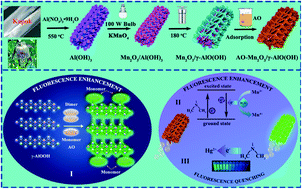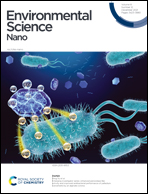Micromotor-assisted fluorescence detection of Hg2+ with bio-inspired AO–Mn2O3/γ-AlO(OH)†
Abstract
Micromotors have held great promise for environmental treatment due to their unique self-propelled movement that can significantly accelerate the chemical process in solution. Herein, we have developed a new AO–Mn2O3/γ-AlO(OH) fluorescent micromotor using renewable and uniquely hollow kapok fibers as biological templates. The AO–Mn2O3/γ-AlO(OH) micromotor was powered by the asymmetric decomposition of hydrogen peroxide fuel catalyzed by Mn2O3, reaching a maximum speed of 139.6 μm s−1 in 3% H2O2 solution. The micromotor revealed a markedly enhanced fluorescence effect compared to both pure AO solution and non-micromotor counterparts and exhibited excellent selectivity and sensitivity for Hg2+ detection. The detection range and limit for Hg2+ were 5 × 10−8–5 × 10−5 M and 2.25 × 10−8 M, respectively. The enhanced Hg2+ sensing benefited from the synergy of enhanced fluorescence via the inhibition of the dimerization of AO, fluorescence quenching induced by charge transfer and the enhanced contact between the micromotor and Hg2+ ions resulted from the self-propelled motion. This micromotor-assisted fluorescence detection idea provided a new strategy for the development of sensors with high sensitivity.



 Please wait while we load your content...
Please wait while we load your content...